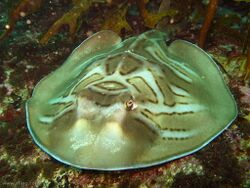Biology:Fiddler ray
| Fiddler rays | |
|---|---|

| |
| Trygonorrhina fasciata from Botany Bay | |
| Scientific classification | |
| Domain: | Eukaryota |
| Kingdom: | Animalia |
| Phylum: | Chordata |
| Class: | Chondrichthyes |
| Subclass: | Elasmobranchii |
| Superorder: | Batoidea |
| Order: | Rhinopristiformes |
| Family: | Rhinobatidae |
| Genus: | Trygonorrhina J. P. Müller & Henle, 1838 |
Trygonorrhina, also known as the fiddler rays or banjo rays, is a genus of guitarfish, family Rhinobatidae. The two species are found along the eastern and southern coasts of Australia . They are benthic in nature, favoring shallow, sandy bays, rocky reefs, and seagrass beds. The eastern fiddler is found to a depth of 120 cm and the southern fiddler to a depth of 180 cm.[1][2]
The flattened pectoral fin discs of fiddler rays are shorter and more rounded than those of other guitarfishes. Their tails are slender, with a well-developed caudal fin and two triangular dorsal fins.[3] Their snouts are translucent.[1] The fiddler rays are also distinguished from other guitarfishes in that the anterior nasal flaps of their nostrils are expanded backwards and fused together into a nasal curtain that reaches the mouth.[4]
Fiddler rays feed on bottoms shellfish, crabs, and worms, which they crush between their jaws.[1] The eastern fiddler ray is known to scavenge from fish traps.[4] Like other guitarfishes, fiddler rays are ovoviviparous. The egg capsules of the southern fiddler ray are reported to be golden in colour, containing three embryos each.[2] It gives birth to litters of four to six young per breeding cycle.[5] Fiddler rays are harmless and easily approached by divers.[1] Southern fiddler rays are taken as bycatch by commercial trawlers and by recreational fishers; the flesh is of good quality and sold in small quantities.[5] The Magpie fiddler ray (previously Trygonorrhina melaleuca) is now considered a variant of Trygonorrhina dumerilii.[6]
Species
There are currently 2 recognized species in this genus:
- Trygonorrhina dumerilii Castelnau, 1873 (Southern fiddler ray)[6]
- Trygonorrhina fasciata J. P. Müller & Henle, 1841 (Eastern fiddler ray)
References
- ↑ 1.0 1.1 1.2 1.3 Aitken, K. (2002): Southern Fiddler Ray (Trygonorrhina dumerilii) & Eastern Fiddler Ray (Trygonorrhina faciata). Rhinobatidae . Marine Themes.
- ↑ 2.0 2.1 Froese, Rainer and Pauly, Daniel, eds. (2015). "Trygonorrhina fasciata" in FishBase. April 2015 version.
- ↑ McGrouther, M. (2006): Eastern Fiddler Ray, Trygonorrhina faciata . Australian Museum.
- ↑ 4.0 4.1 Compagno, L.J.V.; Last, P.R. (1999). "Rhinobatidae: Guitarfishes". in Carpenter, K.E.. FAO identification guide for fishery purposes. The living marine resources of the Western Central Pacific. Rome: Food and Agricultural Organization of the United Nations. ISBN 92-5-104302-7.
- ↑ 5.0 5.1 Huveneers, C. (2015). "Trygonorrhina fasciata". IUCN Red List of Threatened Species 2015: e.T41866A43270478. doi:10.2305/IUCN.UK.2015-4.RLTS.T41866A43270478.en. https://www.iucnredlist.org/species/41866/43270478. Retrieved 13 November 2021.
- ↑ 6.0 6.1 Donnellan, S.C., Foster, R., Junge, C., Huveneers, C., Rogers, P., Kilian, A. & Bertozzi, T. (2015): Fiddling with the proof: the Magpie Fiddler Ray is a colour pattern variant of the common Southern Fiddler Ray (Rhinobatidae: Trygonorrhina). Zootaxa, 3981 (3): 367–384.
Wikidata ☰ Q3541202 entry
 |

